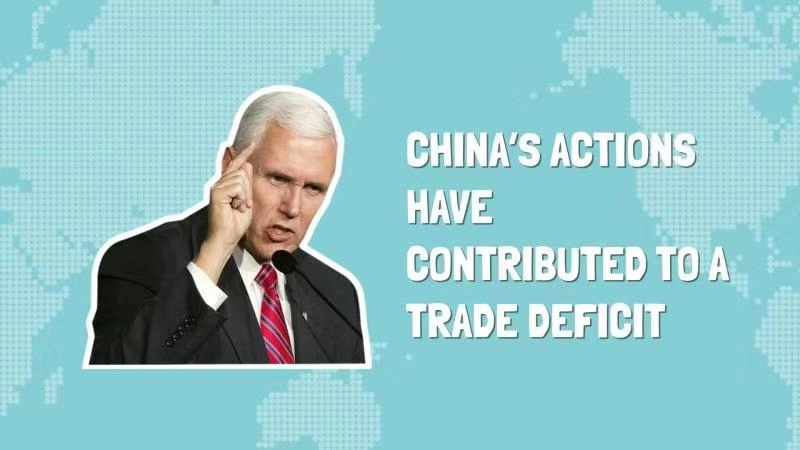
Opinions
16:18, 12-Nov-2018
US-China trade deficit: Separating facts from fiction
Updated
15:29, 15-Nov-2018
CGTN
03:37

The messages of politicians in Washington about the US' trade deficit with China are beginning to sound like a broken record.
“China's actions have contributed to a trade deficit with the United States that last year ran to 375 billion US dollars - nearly half of our global trade deficit,” said US vice president Mike Pence.
If it sounds familiar, that's because we've heard this rhetoric before. But is what he said true? Why is the US trade deficit with China this big?
First off, because this number only includes goods and excludes services. Here's a fun fact: in 2017, America achieved a surplus of 40 billion dollars in service trade with China - 30 times more than 10 years ago.
Meanwhile, its service exports to China increased 3.4 times to over 57 billion US dollars. That's almost double the growth of US service exports to other parts of the world.
Second, the so-called deficit dismisses the role of global value chains. Take iPhones for example. They're designed in the US and assembled in China with components imported from South Korea and elsewhere.

CGTN Photo
CGTN Photo
Yet, when the final product is shipped to the US, it is counted as an export from China. If measured on a value-added basis, America's trade deficit with China would fall by about 100 billion dollars.
This "deficit" also comes at a time when the US is imposing restrictions on exports solely to China.
According to a Carnegie report, the deficit will be cut by 24 percent if the US export controls on China are relaxed to a level similar to of those on Brazil, and the gap reduced by 35 percent if loosened to that of France. It's not that China is not buying; it's the US that's not willing to sell. Still, China is consuming more US products. Last year, America sold nearly 130 billion US dollars of goods to China, a 577-percent increase from 2001, and five times higher than the average export growth to other parts of the world.
Pence called China a robber and the US a victim: “Over the past 17 years, China's GDP has grown nine-fold. American investment in China drove much of this success. As President Trump said, in his words, 'We rebuilt China' over the last 25 years.”

CGTN Photo
CGTN Photo
But you see, US investment in China accounts for less than 10 percent of total foreign investment in the country since the 1980s.
Truth is the US has made huge profits from investing in China. GM, Ford, Boeing, Intel, Microsoft, Qualcomm, you name it.
Pence also accused China of “economic aggression,” saying Beijing pays lip service to “reform and opening up.”
That's alarming. China's contribution to world economic growth has stood at 30 percent since 2013. Last year, it was 34.6 percent, about twice that of the US.
A report by the US-China Business Council shows China's economic ties with America supported about 2.6 million jobs there. But what did the US do? In 2017, it restricted over 20 foreign companies, half of these companies are Chinese, from entering the US market using “national security” as an excuse.
It seems that not a single argument by Mr. Pence holds water.
Scriptwriter: Li Linxi
Voice-over: Michael Wang
Animation consultant: Luo Qing
Animation director: Wu Xiao, Song Yuhan
Animation post-production: Yuan Min, Zhang Ning,Song Yuhan, Wu Xiao
(If you want to contribute and have specific expertise, please contact us at opinions@cgtn.com)

SITEMAP
Copyright © 2018 CGTN. Beijing ICP prepared NO.16065310-3
Copyright © 2018 CGTN. Beijing ICP prepared NO.16065310-3